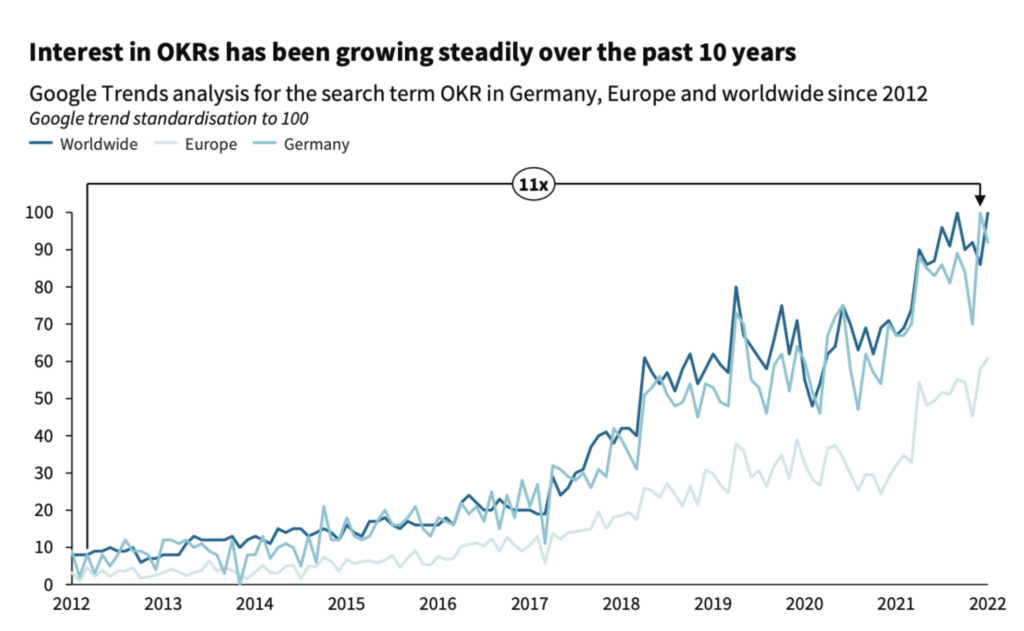This article is part of our series on subscription strategies, whether you’re looking to launch your subscription offer or optimize an existing one. 😃
This series covers all aspects of the topic: acquisition, conversion, customer retention, and KPIs.
OKRs – Objectives and Key Results – are a management method for setting and measuring goals within an organization, helping it achieve its overarching vision.
Derived from Peter Drucker’s work in the 1950s and then developed and enriched by Andy Grove at Intel in the early 1980s, the OKR method gained widespread popularity through its adoption by Google in 1999.
Today, many companies with a subscription-based business model, such as Amazon, Netflix, or LinkedIn, highly praise this approach.
Thanks to its flexibility, goal management facilitates task prioritization and continuous performance improvement, while promoting transparency and employee engagement.
Discover how this method can transform your strategic and operational management.
Definition of OKRs
The OKR method—translatable as “objectives and key results” – combines two elements:
- Objectives: What do we want to accomplish ?
Objectives are qualitative and memorable descriptions of what the organization aims to achieve within a given period.
They should be short, motivating, and engaging to encourage the team to excel and stay focused on the overarching goal.
Objectives must be clear and inspiring, aligned with the company’s mission, and ambitious enough to stimulate motivation.
However, they should also be realistic and achievable with available resources to ensure that teams can fully commit to their achievement while maintaining a concrete and achievable goal.
- Key Results: How do we measure the achievement of these objectives ?
Key Results are specific and measurable indicators that track progress towards achieving an objective.
Each objective should be associated with 2 to 5 Key Results, a number sufficient to provide an accurate assessment of success without overwhelming the team with hard-to-remember indicators.
These results serve as criteria for objectively evaluating performance and ensuring that objectives do not remain abstract.
By focusing on precision and measurability, Key Results translate objectives into concrete and assessable actions, ensuring rigorous monitoring and measurable progress.
Linking OKRs to Initiatives: OKRi
To translate OKRs into concrete and impactful actions, it is essential to associate them with strategic initiatives.
Initiatives are specific and targeted projects or actions designed to achieve the defined Key Results.
They form the operational roadmap of the organization, clarifying and prioritizing projects that will have a direct impact on achieving the objectives.
Important : It is essential to view OKRs as an ongoing process rather than static objectives.
Fixed objectives, if not regularly reviewed and adjusted based on evolving conditions, quickly become outdated and lose their relevance.
What makes OKRs truly effective is the combination of clear and inspiring objectives with a limited set of specific and measurable results, along with a regular process of monitoring and adjustment.
Difference Between KPI and OKR
Unlike KPIs (Key Performance Indicators), which are performance indicators used to evaluate the effectiveness of a specific initiative or process, OKRs are a broader framework for defining and achieving strategic objectives.
While KPIs are often integrated into OKRs to measure specific aspects of performance, OKRs stand out for their ability to align the entire organization around common and ambitious goals.
Why Define OKRs ?
Defining OKRs offers several benefits for an organization:
– Aligning teams on a common goal: OKRs ensure a shared direction, preventing team silos and ensuring that all efforts are focused on the same strategic priorities.
– Motivating and empowering employees: By setting important goals, OKRs encourage employee engagement, as they see their contributions valued and aligned with the company’s overall vision. The OKR approach empowers teams at all levels, offering autonomy similar to that of small startups, as seen at Google.
– Fostering continuous improvement: OKRs enable precise measurement of progress by linking each action to measurable Key Results. This facilitates regular performance tracking and encourages quick adjustments to optimize goal achievement.
– Autonomy and flexibility: By empowering teams at the most operational levels, OKRs encourage management based on trust and autonomy. Managers are encouraged to grant teams more freedom to adapt their actions based on results and needs.
Info : According to the OKR Impact Report 2022, over 70% of companies using OKRs have seen a notable improvement in task prioritization and team focus, illustrating the superior effectiveness of this method compared to using isolated performance indicators.

How to create OKRs ?
To establish effective OKRs, follow these key steps:
- Define annual objectives: Start by setting the company’s annual objectives, ensuring they align with the organization’s mission and core values. These objectives should be ambitious and reflect long-term strategic priorities.
- Identify key results and set KPIs: For each objective, identify Key Results that will measure progress. These results should be specific and quantifiable to provide precise success criteria. Next, establish Key Performance Indicators for each Key Result to track the effectiveness of implemented initiatives.
- Develop Specific Initiatives: Define concrete initiatives for each Key Result, specifying the actions needed to achieve the objectives.
Ensure that each initiative is clearly assigned to a team or department to guarantee clear responsibility and effective implementation.
- Communicate Transparently: Ensure clear and regular communication of OKRis throughout the organization. This transparency is essential for team alignment and common understanding of strategic objectives.
- Use Tracking Tools: Implement a dashboard to track OKRis in real-time, allowing clear visualization of progress and timely adjustments.
- Organize Regular Meetings: Hold periodic meetings to assess OKR progress, discuss obstacles, and celebrate successes, thus reinforcing a culture of transparency and continuous improvement.
By following these steps, companies can create effective OKRs that support their overall strategy while fostering a collaborative and performance-oriented work environment.
Setting SMART objectives
For OKRs to be truly effective, it is important that objectives follow SMART principles:
- Specific: Clearly formulated, indicating what is expected.
- Measurable: Quantifiable criteria are needed to track progress.
- Achievable: Objectives should be ambitious enough to encourage teams to exceed themselves while remaining realistic to avoid discouragement. Ideally, achieving about 60 to 70% of the objectives is considered a good result. If objectives are met 100%, it indicates they are not challenging enough and should be adjusted upward.
- Realistic: They must be relevant to the team’s capabilities and existing constraints. Overly ambitious goals may discourage and undermine confidence.
- Time-bound: A clear deadline is essential to create a sense of urgency and maintain a steady pace.
By adhering to these principles, OKRs become an effective tool to enhance performance and foster innovation within the company.
Best Practices
To maximize the impact of OKRs, consider adopting these best practices:
- Prioritize high-impact objectives: Focus efforts on a limited number of OKRs that are most aligned with the company’s strategy. This helps maintain a clear focus and avoids resource dispersion.
- Adopt an appropriate review rhythm: Adjust the frequency of OKR reviews based on the needs of your organization. For example, quarterly reviews for Key Results and monthly check-ins for initiatives allow for agility and quick responses to environmental changes.
- Make communication a strategic pillar: Regularly organize meetings to share progress, discuss obstacles, and adjust priorities. Frequent and transparent communication reinforces alignment and team engagement.
- Use advanced tracking tools: An automated dashboard can help visualize progress in real-time, facilitating quick decision-making and adjustment of strategies based on available data.
Advice: Keep in mind Goodhart’s Law! “When a measure becomes a target, it ceases to be a good measure.”
Avoid turning performance indicators into ends in themselves, as this can lead to counterproductive behaviors and excessive focus on metrics that may not always reflect overall performance reality.
It is important to diversify indicators for a more comprehensive view of success.
Examples of OKRs
Here are some examples of OKRs to better understand their practical application:
1. Enhancing brand awareness
Objective: Increase brand visibility and recognition in the market.
- Key Result 1: Achieve a 30% increase in brand mentions on social media.
- Initiative: Launch a targeted influencer marketing campaign.
- KPI: Number of brand mentions on social media.
- Team: Marketing, Public Relations.
- Key Result 2: Increase organic website traffic by 25% by the end of the quarter.
- Initiative: Publish high-quality content on the blog and optimize existing articles for SEO.
- KPI: Organic website traffic.
- Team: Marketing, SEO.
- Key Result 3: Obtain media coverage in at least five major publications.
- Initiative: Build relationships with journalists and write impactful press releases.
- KPI: Number of articles published mentioning the brand.
- Team: Public Relations, Marketing.
2. Optimizing operational efficiency
Objective: Improve internal process efficiency to reduce costs and increase productivity.
- Key Result 1: Reduce operational costs by 15% by the end of the year.
- Initiative: Implement lean management processes to minimize waste.
- KPI: Total operational costs.
- Team: Operations, Finance.
- Key Result 2: Increase team productivity by 20% by optimizing workflows
- Initiative: Integrate a new project management tool and train teams on its use.
- KPI: Tasks completed per team per month.
- Team: Operations, IT, Human Resources.
- Key Result 3: Reduce average cycle time of key internal processes by 25%.
- Initiative: Analyze and automate repetitive steps in key processes.
- KPI: Average cycle time per process.
- Team: Operations, IT.
3. Enhancing employee engagement
Objective: Increase employee engagement within the company.
- Key Result 1: Achieve an employee satisfaction rate above 85%.
- Initiative: Implement recognition and reward programs.
- KPI: Participation rate in recognition programs.
- Team: Human Resources.
- Key Result 2: Reduce employee turnover rate to less than 10% per year.
- Initiative: Develop training and professional development opportunities.
- KPI: Number of training hours per employee.
- Team: Human Resources, Training and Development.
- Key Result 3: Increase employee participation in internal surveys to 90%.
- Initiative: Improve internal communication about the importance of surveys.
- KPI: Survey response rate.
- Team: Internal Communication, Human Resources.
Achieving Organizational Excellence with OKRs
Adopting the OKR method can profoundly redefine how companies set priorities and measure success.
By linking strategic objectives to specific, measurable Key Results and promoting a culture of openness and accountability,
OKRs not only improve performance but also enhance team engagement at all levels, creating clear alignment and a strengthened spirit of collaboration.
By applying best practices and avoiding common pitfalls, companies can fully leverage this proven tool to achieve their goals in an agile and consistent manner, positioning themselves advantageously in an ever-evolving economic landscape.
Bonus: FAQ on OKRs
What is the difference between KPI and OKR ?
KPIs are specific performance indicators that measure the effectiveness of an activity.
In contrast, OKRs are a broader framework that sets ambitious goals (Objectives) and measures their achievement through Key Results.
KPIs can be part of OKRs to track progress.
Why use OKRs?
OKRs are used to align all teams on common goals, increasing cohesion and engagement.
They also help prioritize tasks, empower employees, and improve overall performance by tracking measurable actions.
How to track OKRs?
Tracking OKRs is typically done using a dashboard that centralizes key data, with regular meetings to assess progress and adjust strategies.
It’s important to adopt an iterative approach, regularly reviewing OKRs to ensure they remain aligned with company goals.
What are the elements of OKRs?
OKRs consist of three elements: Objectives (what we want to achieve), Key Results (specific measures to track the achievement of objectives), and Initiatives (specific actions taken to achieve the results).
These elements work together to guide efforts towards the organization’s strategic priorities.
Read also :
→ Usage Economy: Definition and perspective on sustainable consumption
→ Everything you need to know about the Freemium Model
→ All the benefits of the Subscription Business Model
→ How to improve your operations management with Dashboards
→ AARRR: The essential framework for driving business growth




